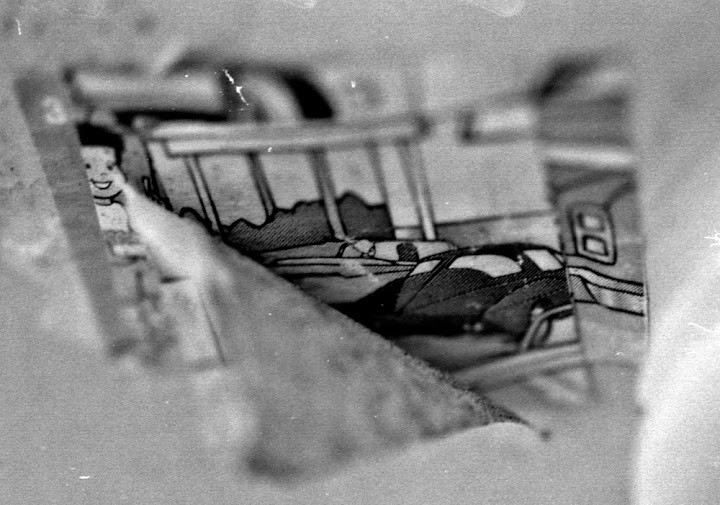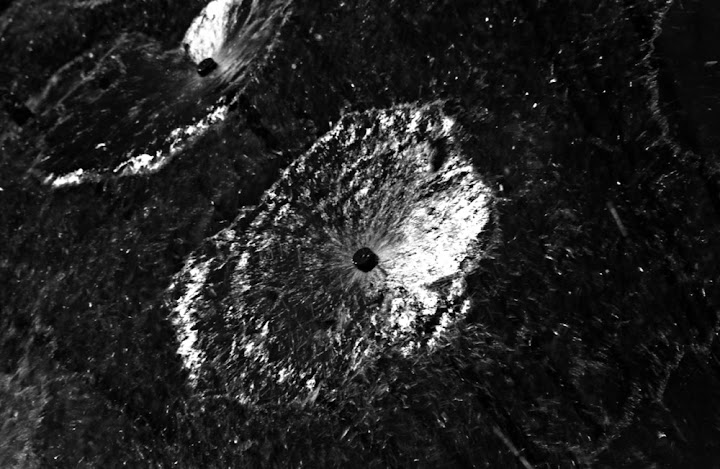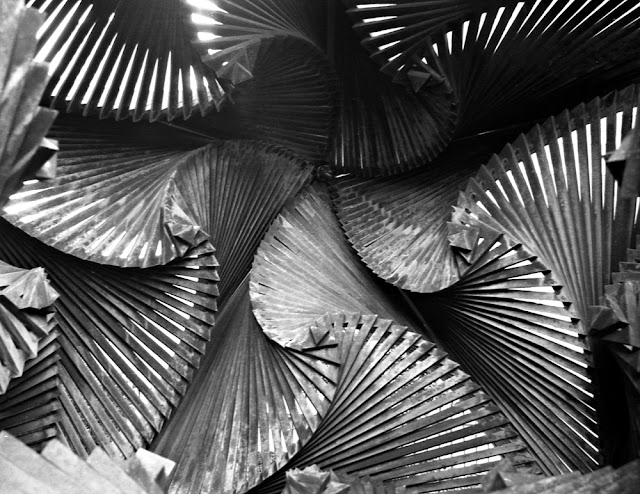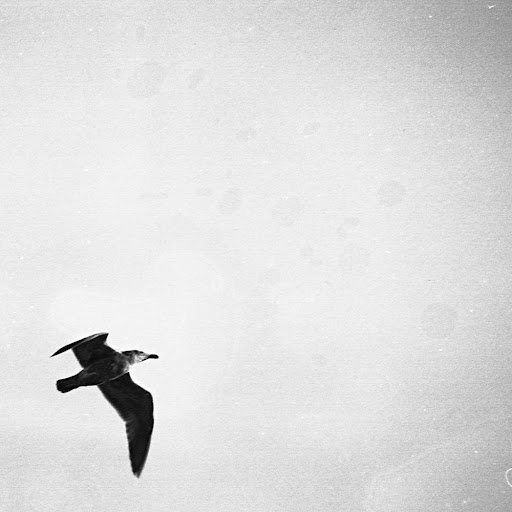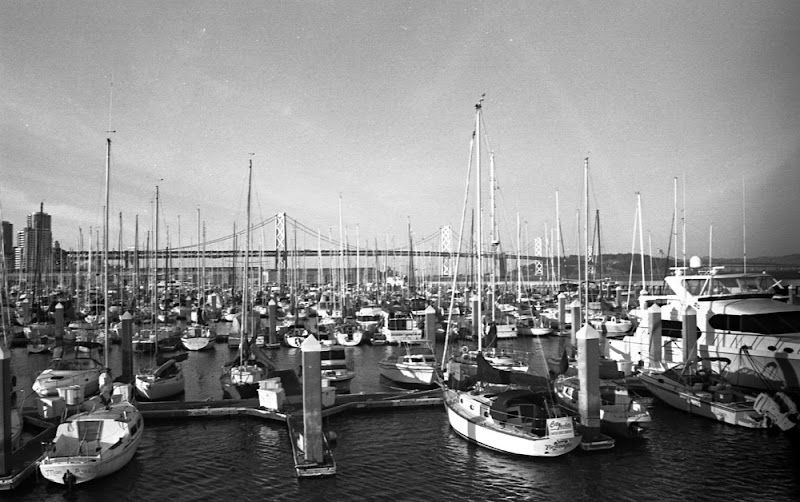Monochrome photography benefits greatly from filtration. But filters present a problem, too, in that they can increase glare and reduce image quality. Low-end filters, made of plastic or plexiglass, especially reduce image quality. Basically, using cheap filters on a nice lens cripples its performance, like putting a quarterback in a cast. Good filters can be $50 or $75 for a basic ultraviolet filter. Polarizing filters, $200. That said, I don't have any super-nice lenses, nor am I sitting on any $200 filters. I do have a set of filters I bought on eBay for $15 from a seller in China. They are of such poor quality that the dye job on the blue filter is not even consistently dense. That said, the results below are not going to be as dramatic as could be achieved with good filters. Also, the results below are simply for illustration of basic function. That's why they're a fairly boring image repeated over and over.
Firstly, here is the test chart I used for these samples.

It's important to understand how this will look rendered monochrome.
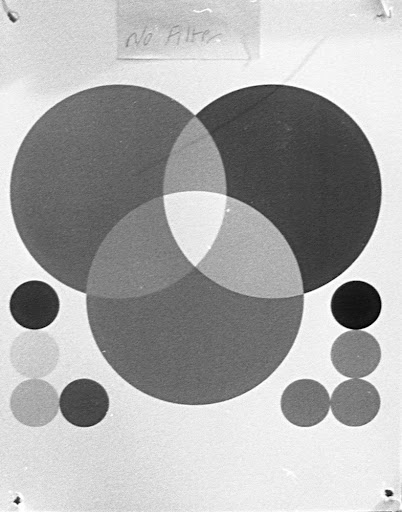
This was taken with Pro Max 100 ISO film. Now, had I known last week what I know today about Pro Max, I would have used something else. Pro Max, apparently, is rebranded Agfa. Agfa stopped making film in 2004, but apparently the company they used to make Agfa brand film still makes the same film for resale as generic brands.
All monochrome films see color. A monochrome film's ability to see color is called the spectral sensitivity. In fact, most films have spectral sensitivity charts posted online somewhere on the manufacturer's websites.
Here is a link to a PDF for a film I'm fond of: Ilford PANF 50 ISO. The first page of this PDF has the chart you'll want to at least glance at before reading further.
So let's understand exactly what Ilford tells us here about their film:

I've reproduced (without permission but also hopefully without hurt feelings) Ilford's chart. This chart does not tell the whole story and you should visit Ilford's website and use their guidance when you use this film. That said, the numbers along the bottom are light in wavelength. The levt side, up to about 320 nanometers (nm), is ultraviolet. That's light that we can't see, neither can this film. In fact, UV light can't really penetrate glass. So those UV filter, they provide no additional benefit for your images.
PANF 50 begins seeing light in the dark-blue and violet range. It sees light up to the reds, the 600nm range. Infrared, which humans can't see, begins with near-infrared light at about 680 or 700nm. So this film also cannot see infrared light. The peaks and valleys along the spectral sensitivity line tell you how much each color registers on the film. The higher the peak, the lighter more sensitive the film is to that color, the lighter it will appear on the film. So this curve tells us that if a field of light, from left to right, from 300nm to 800nm were projected at the film, that it would see from dark blue up to red. Further, this tells us that dark blue and dark red would be the darkest shades. Green (500nm) would be the darkest of the middle tones. Orange (600nm) would be the lightest. We see that because the height of the line on the chart correlates to how close to while the film will see a color.
Note that all films have different spectral sensitivities. That means that the same film camera can shoot the same scene a dozen times in a day, each with a different film, and get a dozen different results. Well, that's one advantage for film over digital -- a film camera is as versatile as the film inside it. A digital camera is bound by it's sensor's parameters.
So how this effect film when used with a filter is thus: A filter cannot add light, but it can block light. A red filter is not a red-adding filter, but an everything-but-red-cutting filter. That means a red filter allows red light through but blocks blue, green, purple, yellow, and orange in varying degrees. The amount of non-red light a red filter cuts depends on filter quality, tone, density, dye composition, and so forth. Lots of factors that are too specific for this general conceptual discussion of filters. For this post's purposes, understand that colored filters allow their color to reach the film but prevent other colors.
How does this affect monochrome photography, though. Looking at the spectral sensitivity chart above, adding a red filter would suppress all the wavelengths left of about 625nm. Therefore their curves would be pushed downward. On film, everything not red would appear darker. The further from red that color is, the darker it would appear. Blues would be near-black. Greens, dark charcoal. Yellows, darker gray. Orange, less effected but still darker. Reverse that and put a blue filter on, you'll have near-black rendition for reds, darker oranges, gray yellows, and less-effected greens and purples.
So let's see this in practice. Here again is the test chart without a filter.

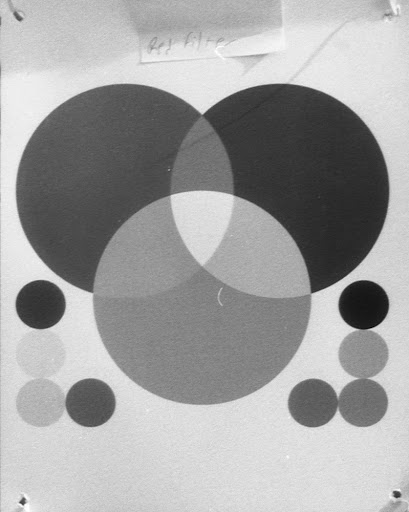
You'll first notice that it appears to have greater contrast. It does. Notice next that the blue and green are much darker than without a filter. The red filter I used is more of a magenta-ish color, so it does not affect blue as greatly as it should. Comparing the two charts, you can see how the color tone is altered between the two images.
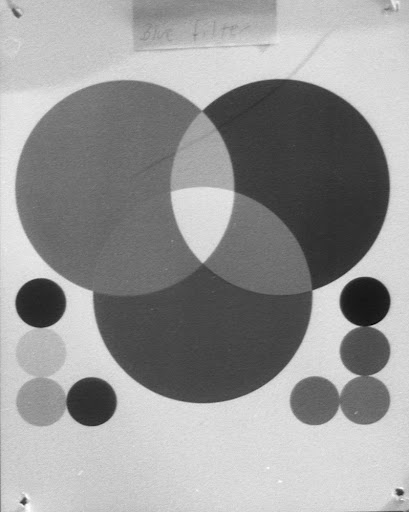
Here the blue filter has made the green darker and the cyan near-white. That's because this blue filter is particularly light colored (and generally poorly dyed.)
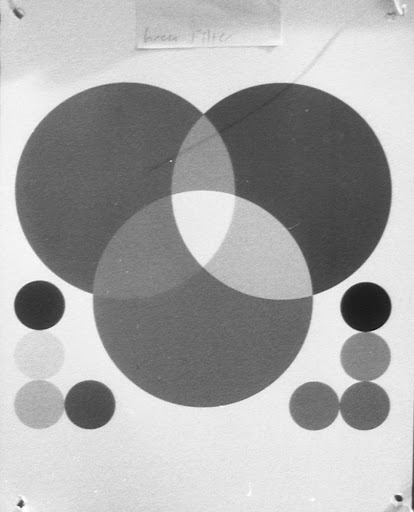
And here is a green filter test shot. You'll see a variation on a theme here. Also, these represent the three prime colors for light -- red, green, and blue. Other colors, obviously, compose the visual spectrum including yellow, orange, purple, and brown. The next images show the chart rendered through various non-prime colors.
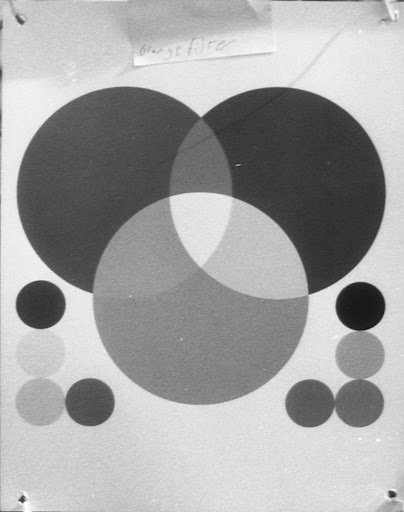
Orange filter

'Tobacco' filter
This filter is actually an 'artistic' filter meant to give a quick and dirty sepia cast to color images. God only knows why it's on a rotating base. Man that makes it hard to get off a lens.

Yellow filter
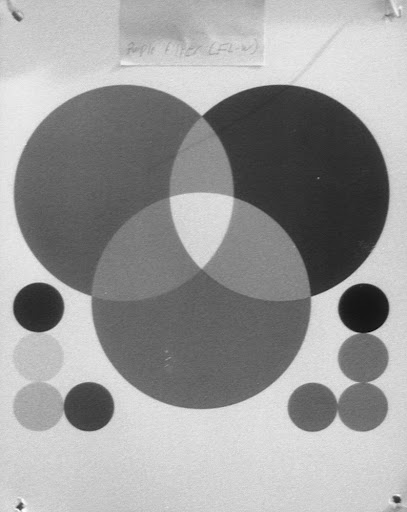
Purple (FL-W) filter
This filter is actually used to correct color cast in fluorescent light. Basically, daylight color film can't be used in fluorescent light without casting everything in sickly green. Slap an FL-W (fluorescent white) filter on, and outdoor film can be used indoors. It's not really a color-correcting filter for monochrome photography.
So you can see, scrolling through the images above, that filters change how monochrome film sees colors. What does that mean in practical application, though.
For decades during early photography, the sky rendered white and only white on film. Cloud photography was impossible. Then came yellow, orange, and red filters which darkened blue hues in varying degrees. Red, of course, provided the most dramatic effect. This led to images with dark skies that fundamentally changed how photographers approached including the sky in their images.
Colored filters also allowed for early color photography though a process called color separation. We'll look at that tomorrow in Part 2 when we repeat this experiment with a DSLR. Do CCDs see color differently than film? We'll see.
So colored filters narrow the wavelength band reaching the film. By separating a real-life scene into the various wavelength bands, photographers captured the first color images and printers created the first colored prints. The process is not dissimilar from a color laser printer where a sheet of paper passes under four toner drums -- cyan, magenta, yellow, and black. Each drum prints only part of the image, leaving everything that is not the drum's color blank. Color separation photography and printing work the same way. Three photos taken with three filters -- red, green, and blue. Each negative is printed on the same paper with the corresponding color. In fact, tomorrow you'll see a color-separation recreation of the test chart above. If nothing else, it demonstrates how cruddy these filters are.
So with that demonstration, let's conclude for today by looking at what happens when we combine filters. Imagine, first the result. Light encounters a blue filter. Much of the non-blue light bounces away. Then it encounters a red filter, blocking again much of the non-red light. So greens and yellows ought to be dark black. Reds and blues ought to be the same basic tone. Let's see.
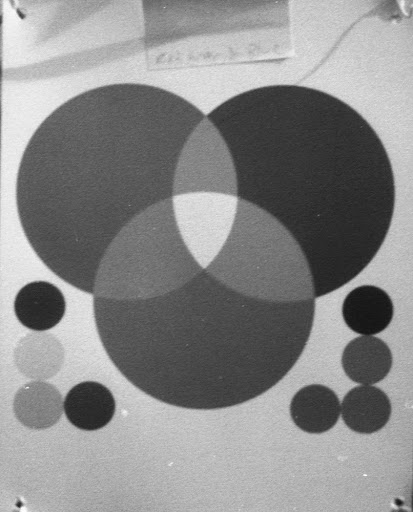
That is about what that looks like to me.

A green and a yellow filter

A blue and an orange filter
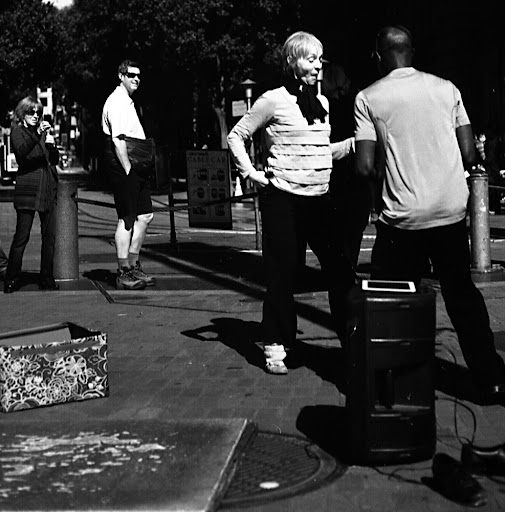

 1/500th, f1.8
1/500th, f1.8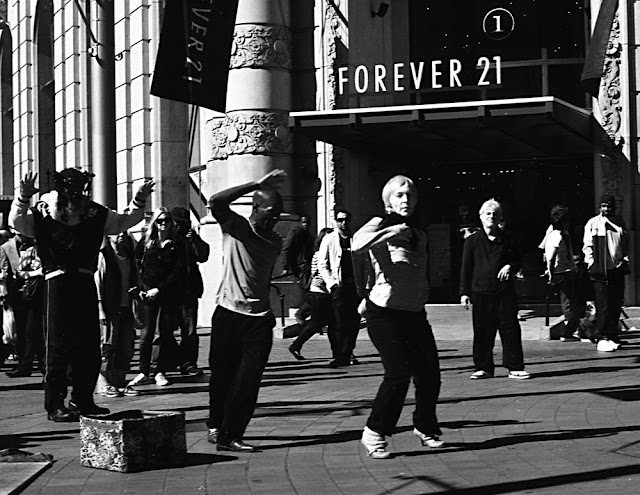
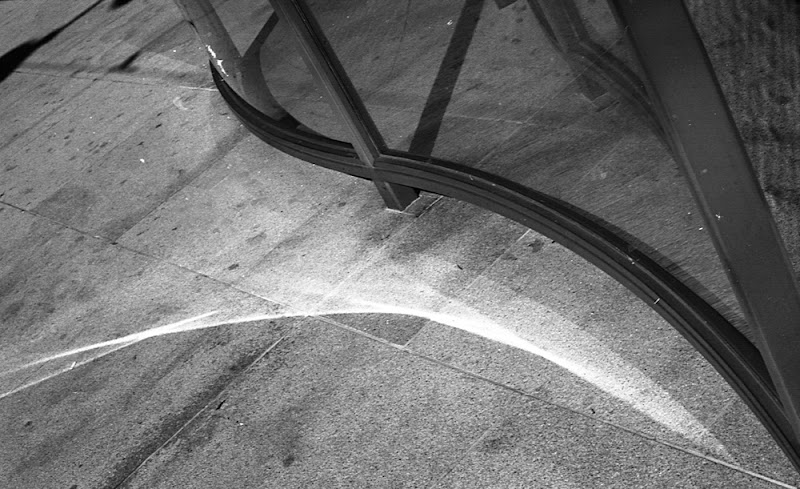




 1/500th, f1.8
1/500th, f1.8











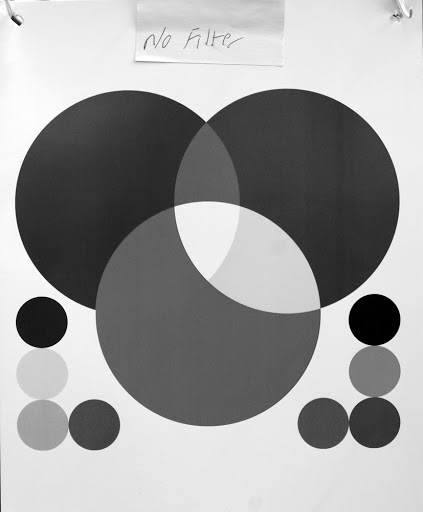





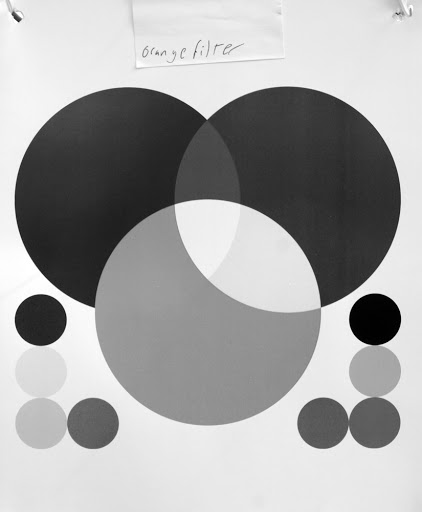








 You'll first notice that it appears to have greater contrast. It does. Notice next that the blue and green are much darker than without a filter. The red filter I used is more of a magenta-ish color, so it does not affect blue as greatly as it should. Comparing the two charts, you can see how the color tone is altered between the two images.
You'll first notice that it appears to have greater contrast. It does. Notice next that the blue and green are much darker than without a filter. The red filter I used is more of a magenta-ish color, so it does not affect blue as greatly as it should. Comparing the two charts, you can see how the color tone is altered between the two images.










